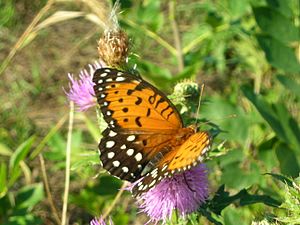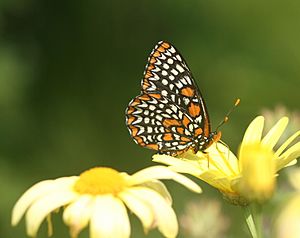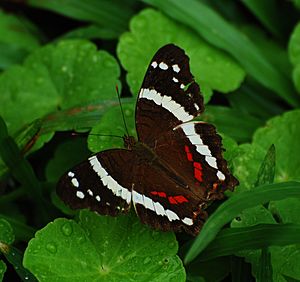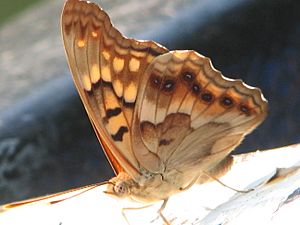List of butterflies of North America (Nymphalidae) facts for kids
Butterflies are amazing insects with colorful wings and fascinating life cycles. The Nymphalidae family, often called "brush-footed butterflies," is one of the largest butterfly families in the world. They get their name because their front legs are very small and brush-like, so they don't use them for walking. Instead, they use them to taste their food!
In North America, you can find many different kinds of Nymphalidae butterflies. They live in various habitats, from forests to deserts, and play an important role in nature, especially as pollinators. Let's explore some of the cool groups within this family!
Contents
- Snout Butterflies (Subfamily Libytheinae)
- Heliconians and Fritillaries (Subfamily Heliconiinae)
- True Brushfoots (Subfamily Nymphalinae)
- Admirals, Sisters, and Others (Subfamily Limenitidinae)
- Leafwings (Subfamily Charaxinae)
- Emperors (Subfamily Apaturinae)
- Morphos (Subfamily Morphinae)
- Satyrs (Subfamily Satyrinae)
- Milkweed Butterflies and Clearwings (Subfamily Danainae)
Snout Butterflies (Subfamily Libytheinae)

Snout butterflies are unique because they have a very long, snout-like mouthpart. This "snout" is actually made up of two long palps that stick out from their head. It helps them find food.
- The most common one you might see is the American snout (Libytheana carinenta). These butterflies are known for their migrations, sometimes flying in huge numbers!
Heliconians and Fritillaries (Subfamily Heliconiinae)

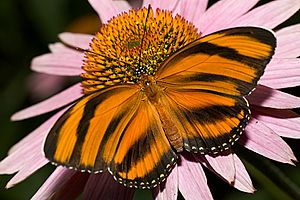
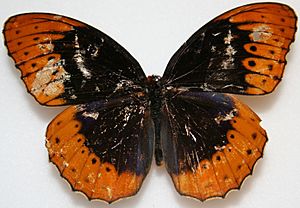
This group includes some of the most beautiful and well-known butterflies.
Heliconians
Heliconians are often brightly colored. Many of them are poisonous to predators, and their bright colors warn birds and other animals to stay away.
- The Zebra heliconian (Heliconius charithonia) has striking black and yellow stripes, just like a zebra!
- The Banded orange heliconian (Dryadula phaetusa) shows off vibrant orange and black patterns.
Fritillaries
Fritillaries are known for their orange and brown wings, often with silver spots on the underside. They are fast flyers and are usually found in open fields and meadows.
- The Gulf fritillary (Agraulis vanillae) is a common sight in warmer areas, with bright orange wings.
- The Diana fritillary (Speyeria diana) is special because the males and females look very different. Males are orange and black, while females are dark blue and black.
- The Regal fritillary (Speyeria idalia) is a large, beautiful butterfly with deep orange and black wings, and bright white spots on the hindwings.
True Brushfoots (Subfamily Nymphalinae)

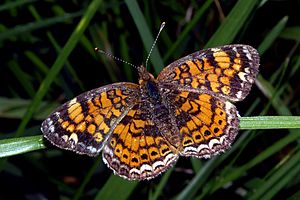
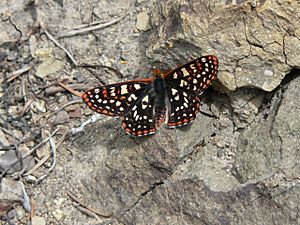
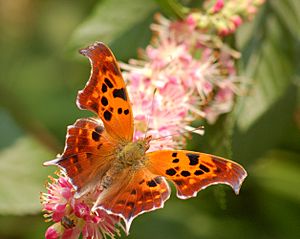
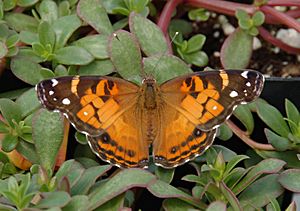
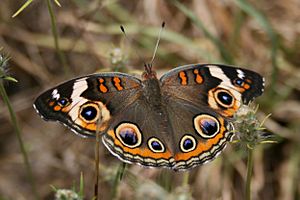
This is the largest group of brush-footed butterflies. They come in many shapes, sizes, and colors.
Checkerspots and Crescents
These butterflies often have checkered patterns on their wings.
- The Silvery checkerspot (Chlosyne nycteis) has a distinct silvery spot on its underside.
- The Pearl crescent (Phyciodes tharos) is a small, common butterfly with orange and black patterns.
- The Baltimore checkerspot (Euphydryas phaeton) is known for its striking black, orange, and white pattern.
Anglewings and Tortoiseshells
These butterflies have jagged wing edges, which help them blend in with tree bark or dead leaves.
- The Question mark (Polygonia interrogationis) has a small silver mark on its hindwing that looks like a question mark!
- The Mourning cloak (Nymphalis antiopa) is one of the longest-living butterflies, often seen in early spring.
Ladies and Admirals
These are some of the most widespread and recognizable butterflies.
- The American lady (Vanessa virginiensis) and the Painted lady (Vanessa cardui) are famous for their long migrations across continents.
- The Red admiral (Vanessa atalanta) is a common visitor to gardens, with bold red bands on its dark wings.
Buckeyes and Peacocks
These butterflies often have large, eye-like spots on their wings, which can scare away predators.
- The Common buckeye (Junonia coenia) has prominent eyespots on its wings.
- The Banded peacock (Anartia fatima) is a colorful butterfly with bright bands and eyespots.
Admirals, Sisters, and Others (Subfamily Limenitidinae)
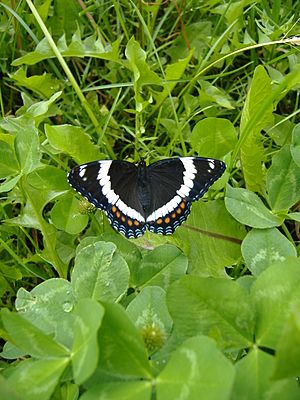


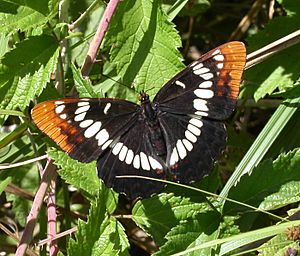
This group includes some well-known butterflies, famous for their mimicry.
- The Viceroy (Limenitis archippus) is a master of disguise! It looks very similar to the Monarch butterfly, even though it's not poisonous. This helps it avoid being eaten by birds that have learned to avoid Monarchs.
- The White admiral (Limenitis arthemis arthemis) has a white band across its wings.
- The Red-spotted purple (Limenitis arthemis astyanax) is a beautiful, iridescent blue-black butterfly. It's actually the same species as the White Admiral, but it looks very different!
- The Lorquin's admiral (Limenitis lorquini) is found in western North America and has orange tips on its forewings.
Leafwings (Subfamily Charaxinae)
Leafwings are amazing at camouflage! When their wings are closed, they look exactly like dead leaves, complete with veins and irregular edges. This helps them hide from predators.
- The Tropical leafwing (Anaea aidea) is a great example of this incredible camouflage.
- The Goatweed leafwing (Anaea andria) is another common leafwing found in North America.
Emperors (Subfamily Apaturinae)
Emperor butterflies are often duller in color, usually shades of brown and gray, which helps them blend in with tree bark. They are known for being attracted to sap and rotting fruit.
- The Hackberry emperor (Asterocampa celtis) and Tawny emperor (Asterocampa clyton) are common in areas with hackberry trees, which their caterpillars eat.
Morphos (Subfamily Morphinae)
Morpho butterflies are famous for their dazzling, iridescent blue wings, though some species are white. Their wings reflect light in a special way, making them appear to shimmer.
- The White morpho (Morpho polyphemus) is a stunning white butterfly found in parts of North America.
Satyrs (Subfamily Satyrinae)
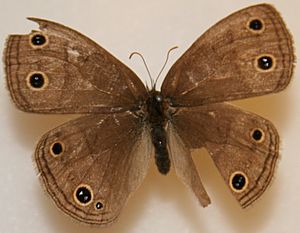
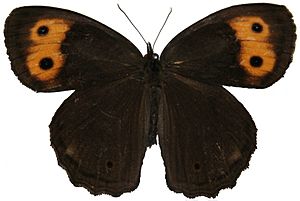
Satyrs are typically brown or gray butterflies, often with small eyespots on their wings. They usually fly close to the ground in grassy or wooded areas.
- The Little wood-satyr (Megisto cymela) is a common sight in woodlands.
- The Common wood-nymph (Cercyonis pegala) is a larger satyr with several eyespots.
- The Red-bordered satyr (Gyrocheilus patrobas) has a distinctive reddish border on its wings.
Milkweed Butterflies and Clearwings (Subfamily Danainae)
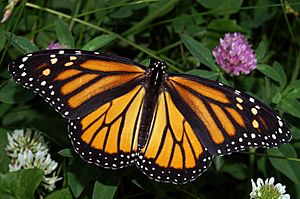
This subfamily includes some of the most iconic butterflies, known for their long migrations and the way their caterpillars feed on milkweed plants.
- The Monarch (Danaus plexippus) is perhaps the most famous butterfly in North America, known for its incredible long-distance migrations to warmer climates for winter. Its caterpillars feed only on milkweed, which makes the butterflies toxic to predators.
- The Queen (Danaus gilippus) and Soldier (Danaus eresimus) are close relatives of the Monarch, also found in warmer regions.
- Clearwing butterflies like the Thick-tipped Greta (Greta morgane) have transparent wings, which helps them hide from predators by making them harder to see.


